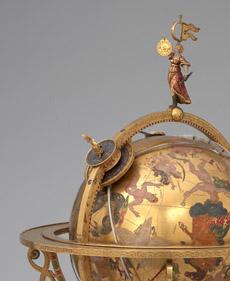This research project focused on the various relations between natural philosophy, i.e., astronomical and astrological knowledge, and artistic production in the field of clockworks, especially table clocks, in the premodern age. In the beginning of the sixteenth century two important innovations changed the production of clocks profoundly: first the introduction of the spring drive, that led to the construction of very small clock works and second the use of metal and brass instead of iron, which allowed a greater group of smiths to enter the domain of clock making.
The essential question addressed to these objects is how gold- and silversmiths and clock makers assimilated theoretical knowledge in their practical working process, and how they materialize this knowledge, first in the elementary designing processes and second in the many varieties of definite forms, in which they shape astronomical knowledge and notions of time engaging into discourses about the harmony of the spheres, the clockwork as first mover or God, or the superiority of technical innovation conceptualized as one of the wonders of the world.
Furthermore, Susanne Thuerigen sought to elucidate the forms of sensory experience of this knowledge as well as the different levels of reception of astronomical and astrological knowledge. With her dissertation thesis Thuerigen aimed to make a contribution to the broader discussed question of the involvement of artists and artisans in the scientific revolution in the sixteenth and seventeenth centuries.

Mechanical Celestial Globe Clock by Georg Roll and Johann Reinhold, 1584, Kunsthistorisches Museum, Wien.
Project
(2015)
Objects of Knowledge or: The Shape of Time—Astronomical Table Clocks in Southern German Cities, 1510–1650
- Susanne Thuerigen
